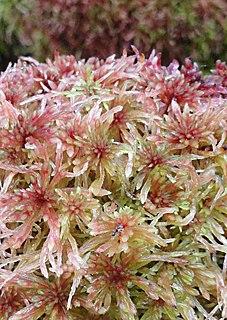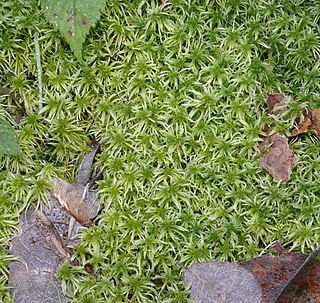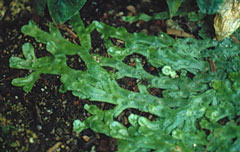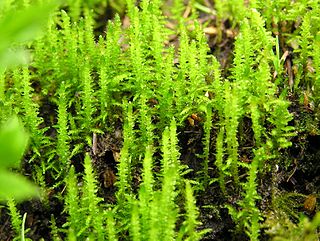
Riccia fluitans, the floating crystalwort, is an aquatic floating plant of the liverwort genus Riccia which is popular among aquarists as a retreat for young fry and is used in live-bearing tanks. It can be found floating in ponds, and often forms thick mats on and under the water surface.
Coslett Herbert Waddell (Rev.) was an Irish priest,, and botanist.

Bryology is the branch of botany concerned with the scientific study of bryophytes. Bryologists are people who have an active interest in observing, recording, classifying or researching bryophytes. The field is often studied along with lichenology due to the similar appearance and ecological niche of the two organisms, even though bryophytes and lichens are not classified in the same kingdom.
Bryum warneum, known as sea bryum or Warne's threadmoss, is a protected moss found in sandy coastal areas in temperate regions of Europe and is also recorded to have been found in the Himalaya, the Altai Mountains and in Quebec, Canada.
Thamnobryum angustifolium, the Derbyshire feathermoss, is a species of moss in the Neckeraceae family. It is endemic to Derbyshire, England, being restricted to a single SSSI, where the main colony covers about 3 square metres (32 sq ft) of a single rock face, with small subsidiary colonies nearby. Threats include disturbance from cavers and climbers, collection by bryologists, pollution of the spring in which it grows, and desiccation during periods of drought. Its natural habitat is rivers.

Oedipodium is the only genus of moss in the family Oedipodiaceae. It contains the single species Oedipodium griffithianum, the gouty-moss or Griffith's oedipodium moss. This species is distributed in cooler climates of Eurasia, as well as from Alaska, Washington state, British Columbia, Yukon, Greenland, Newfoundland, Tierra del Fuego and the Falkland Islands.

Sphagnum angustifolium, the fine bogmoss, is a species of peat moss with a Holarctic distribution.

Sphagnum russowii, Russow's sphagnum or Russow's bogmoss, is a species of peat moss with a Holarctic distribution.

Sphagnum girgensohnii, the Girgensohn's bogmoss, Girgensohn's sphagnum or common green peat moss, is a species of peat moss with a Holarctic and Indo-Malesian distribution.

Bartramia halleriana, the Haller's apple-moss or Haller's bartramia moss, is a species of moss in the family Bartramiaceae.

Funaria hygrometrica, the bonfire moss or common cord-moss, is a type of water moss which grows on moist, shady, and damp soil. It can also be found on moist walls and the crevices of rocks and places where recent fires have taken place.

Pellia epiphylla is a species of thallose liverwort. It occurs in North America, Europe, North Africa and parts of Asia. It grows in patches in damp, sheltered places on neutral or acidic substrates. It is common on the banks of rivers, streams and ditches and also grows in wet woodland, marshes and on wet rocks.

Sphaerocarpos texanus, the Texas balloonwort, is a species of liverwort in the Sphaerocarpaceae family, found in the Americas, northern Africa and Europe.

Polytrichum juniperinum, commonly known as juniper haircap or juniper polytrichum moss, is an evergreen and perennial species of moss that is widely distributed, growing on every continent including Antarctica.

Splachnum sphaericum, also known as pinkstink dung moss, is a species of moss. This species occurs in North America. It also occurs in upland Britain, where it is known as round-fruited collar-moss and in north temperate and boreal regions of Europe. Its habitat is bog and wet heathland where it grows on herbivore dung. This and other Splachnum species are entomophilous. The sporophytes, which are generally coloured red or black, produce an odour of carrion that is attractive to flies and the spores are dispersed by flies to fresh dung.

Conocephalum conicum, the great scented liverwort, common mushroom-headed liverwort or snakeskin liverwort, is a liverwort species in the genus Conocephalum .

Palustriella commutata, commonly known as curled hookmoss, is a plant that also goes by the binomial names Cratoneuron commutatum, Cratoneuron falcatum, Hypnum commutatum, and Hypnum falcatum.

Mnium stellare, the starry thyme-moss or stellar calcareous moss, is a moss species in the genus Mnium.

Bazzania trilobata, the greater whipwort or threelobed bazzania, is a species of liverwort in the Lepidoziaceae family. It grows in the northern hemisphere temperate zone.

Calliergon giganteum, the giant spearmoss, giant calliergon moss, or arctic moss, is an aquatic plant found on lake beds in tundra regions. It has no wood stems or flowers, and has small rootlets instead of roots.

















